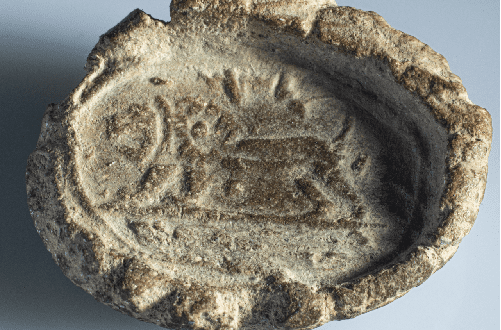The earliest-ever discovery of an imprint of an oval or round seal (bulla, an inscribed clay or soft metal token used in commercial and legal documentation as authentication and for tamper-proofing whatever is attached to it). The discovery, by researchers at Ben-Gurion University (BGU) of the Negev in Beersheba provided the first-ever is real evidence of a royal seal being created in different sizes.
It has just been revealed that the seal was sold in a Beersheba half-a-century ago to a BGU for the pittance of only 10 old shekels (Israel’s currency today is New Israeli Shekels, replacing the old currency in 1986 at a rate of 1,000 to one).
Then-Prof. Yigal Ronen walked around the Beduin market in when he came across a piece of oval material with the engraving of a roaring lion standing on all fours. Ronen asked the merchant where the stamp came from, but the seller didn’t know; he agreed to sell it for a small amount of money.
The shortcode is missing a valid Donation Form ID attribute.
The professor was intrigued when he noticed that the seal bore, above and below the roaring lion, the inscription of the word “To Hear” that it seemed very similar to the famous seal from Megiddo “Servant of Jeroboam.”
And all Yisrael shall lament over him and bury him; he alone of Yerovam‘s family shall be brought to burial, for in him alone of the House of Yerovam has some devotion been found to Hashem, the God of Yisrael. (I Kings 14:13)
Get your hardcover Israel Bible at a limited time discount Today by clicking here
That seal, which was apparently lost at the Constantinople (Istanbul) Museum; all that remains today is the detailed bronze impression that the researchers at Megiddo cast before it left the excavation. In that bronze cast, King Jeroboam’s place in history has been preserved, backing up the biblical account of one of Israel’s most prominent kings. The inscription actually proclaims the name and rank of its owner, one of the ministers of King Jeroboam II who reigned from 787-747 BCE. The word “servant” is the Hebrew word “eved” and is mentioned in the Bible as one of high dignity in the government. with a beautiful curved tail with beautiful workmanship.
The fact that the stamp was sold in a popular market and at a small price immediately raised the concern that it was not an original and ancient find, but Ronen decided to present it to researchers dealing with the subject in order to check its originality. The tests were carried out carefully in collaboration with researchers from BGU, the Geological Survey of Jerusalem and the Israel Antiquities Authority. The team included Prof. Eliezer Oren and Prof. Shmuel Ahituv of BGU; Ben-Gurion University of the Negev; Dr. Avner Ayalon and Dr. Mira Bar-Matius of the Geological Survey; and Dr. Orit Shamir of the Israel Antiquities Authority.
Laboratory tests have shown that the bulla was formed from the soil taken from where limestone rocks were exposed in the vicinity of basalt-containing olivine (magnesium iron silicate), which is similar to that in the Lower Galilee and the Jezreel and Beit She’an valleys. It was also found that the stamp was sealed on a linen cloth when its fabric was in a relatively dry state and then attached at a temperature of about 750 degrees Celsius.
The stamp had an oval shape, and its maximum dimensions are 23.4 by 19.3 millimeters. The embossing area is about 20 X 15 mm and its thickness is about four mm in the embossing area and about six mm in the raised edges. The stamp is coated, mainly on the side of the imprint but also on the edges and back and especially on the depressions, in a layer of white-gray patina. This accumulated over time, after the completion of the bolla. Based all of these data and more, it was decided that the stamp is indeed authentic and original.
After the discovery, the Ronen family agreed to hand over the stamp to the Antiquities Authority and keep it in an exhibition at the Israel Museum in Jerusalem.
The importance of the discovery of the stamp is enormous and threefold: First, just as the seal “To Hear” is today the oldest seal among the Hebrew royal seals, the stamp is the oldest in the historical seal impressions discovered in Israel, the researchers said. Second, for the first time in the history of the study, realistic evidence of a royal seal being produced to in various sizes was exposed. It is a unique and the earliest archaeological find of its kind from the Iron Age in the Land of Israel.
It is worth noting that the seal from Megiddo is almost twice the size of the imprint of the seal. It can be assumed that the seal stamped on the material was in fact a scaled-down version of a seal from the same series that was used by a high-ranking official in the Kingdom of Israel. The stamp signed with the seal of, which is not the same as the seal from Megiddo, indicates that “Servant Jeroboam” had more than one seal and that they were not personal but official seals of a senior official in the state administration of Jeroboam II, King of Israel. He and his officials used his seals to sign documents and shipments of goods on his behalf.
The shortcode is missing a valid Donation Form ID attribute.




